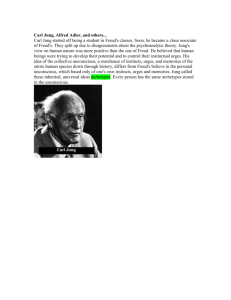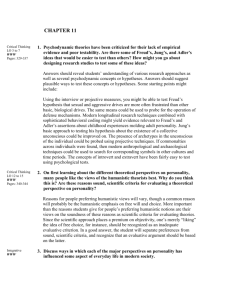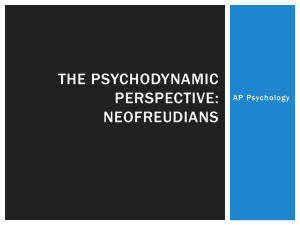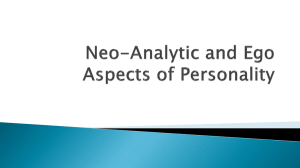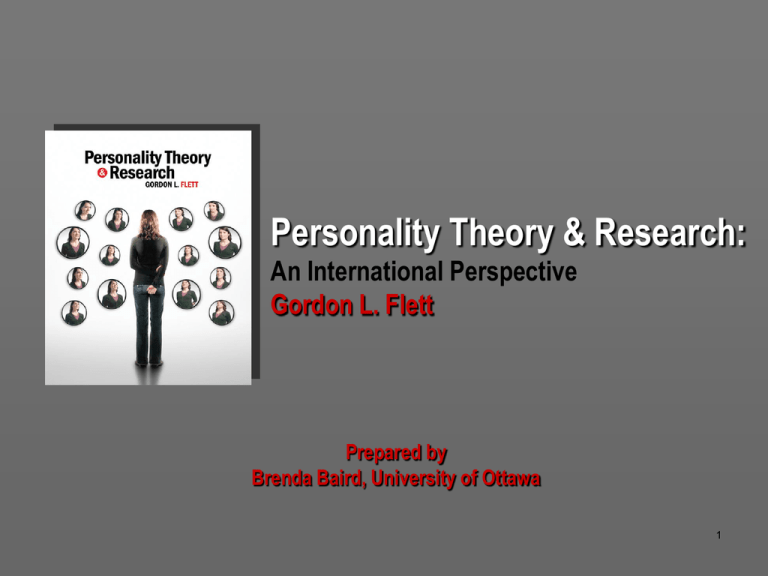
Personality Theory & Research:
An International Perspective
Gordon L. Flett
Prepared by
Brenda Baird, University of Ottawa
1
Chapter 5 Overview
Psychodynamic Theories
• Psychodynamic Theory and Sigmund
Freud
• The Neo-Freudians: Carl Jung‘s Analytical
Psychology
• The Neo-Freudians: Alfred Adler
• The Neo-Freudians: Karen Horney
• Psychodynamic Assessment Techniques
2
Psychodynamic Theory And
Sigmund Freud
• Psychodynamic theorists adhere to the
notion of unconscious influences on
conscious behaviours
• Psychodynamic theorists use introspective
methods as a way to tap into internal
thoughts and images
• Sigmund Freud used the analogy of the
iceberg to depict the complex interplay of
conscious and unconscious forces
• Freud believed that only 10% of personality
is available to conscious awareness
3
Psychodynamic Theory and
Sigmund Freud
Components of the Psyche
Freud’s theory outlines three mental
components:
1. Id : Hedonistic
2. Ego: Realistic
3. Superego: Moralistic
4
Psychodynamic Theory and
Sigmund Freud
Components of the Psyche: The Id
• Unconscious; operates according to the
pleasure principle with no regard for moral
principles
• Primary process thinking achieves
momentary satisfaction and wish
fulfillment
• Insight (catharsis) reduces tension
• Freud termed the libido ‘eros’, and termed
aggression ‘thanatos’
5
Psychodynamic Theory and
Sigmund Freud
Components of the Psyche: The Ego
• Mostly conscious; operates according to
the reality principle
• Tries to align the urge of the id with reality
using secondary process thinking
• The ego considers the situation and past
experience to engage in behaviour
6
Psychodynamic Theory and
Sigmund Freud
Components of the Psyche: The Superego
• Mostly conscious; operates according to
the perfection principle
• Tries to uphold morality by a strict
adherence to societal standards
• Guilt and shame result from immoral
behaviour for those having a strong
superego
7
Psychodynamic Theory and
Sigmund Freud
Components of the Psyche
• Freud drew on Greek mythology to
describe how children internalize parental
values and resolve their desire for the
opposite-sexed parent
• Boys unconsciously desire their mother
(Oedipus Complex) and fear the father,
resulting in castration anxiety
• The conflict is resolved through
identification with the father via a process
Freud termed introjection
8
Psychodynamic Theory and
Sigmund Freud
Components of the Psyche
• Girls unconsciously desire their father
(Electra Complex) and suffer from penis
envy
• Karen Horney challenged Freud’s view
and suggested that males may suffer from
womb envy
• Freud’s concepts have sparked much
controversy
9
Psychodynamic Theory and
Sigmund Freud
Freud’s View on Culture
• Freud viewed culture and civilization as
synonymous
• Freud viewed culture as a source of
dissatisfaction
• Freud suggested a role for id, ego, and
superego at the societal level
• Cultures vary in their balance of eros and
thanatos
10
Psychodynamic Theory and
Sigmund Freud
Freud’s Stage Theory of Psychosexual
Development
• Freud developed a series of four
psychosexual stages:
1.
2.
3.
4.
•
Oral Stage
Anal Stage
Phallic Stage
Genital Stage
Too little or too much gratification within
each stage can result in fixations
11
Psychodynamic Theory and
Sigmund Freud
Defence Mechanisms
• Freud believed there was a specific form of
anxiety associated with each component:
• A controlling id resulted in neurotic anxiety
• A controlling ego resulted in realistic anxiety
• A controlling superego resulted in moral
anxiety
• Defence mechanisms are employed to help
the ego keep neurotic anxiety at bay
12
Psychodynamic Theory and
Sigmund Freud
13
Psychodynamic Theory and
Sigmund Freud
Defence Mechanisms
• Some researchers (e. g., Baumeister, Dale, &
Sommer, 1998) have reported evidence for
reaction formation, projection
• Baumeister et al. also report evidence of another
defence mechanism termed undoing which refers
to a cognitive attempt to reconstruct the past in
order to “undo” the occurrence of an event
• Defence mechanisms can be described as either
adaptive or maladaptive depending on the level of:
–
–
Maturity
Conscious Awareness
14
Psychodynamic Theory and
Sigmund Freud
Contemporary Theory and Research on
Repression and Other Defence Styles
• Contemporary research has identified the
“repressor”
–
–
–
Repressors are described as self-deceptive
Repressors score high on social desirability
Repressors score low on trait anxiety
measures
15
Psychodynamic Theory and
Sigmund Freud
Contemporary Theory and Research on
Repression and Other Defence Styles
• Contemporary research has identified
defence styles
• Defence styles describe the typical way a
person reacts to anxiety
• Questionnaires such as the Defence
Mechanism Inventory and Defence Styles
Questionnaire (DSQ) measure mature,
neurotic and immature defence styles
16
Psychodynamic Theory and
Sigmund Freud
Contemporary Theory and Research on
Repression and Other Defence Styles
• Vaillant (1977, 1992) has structured a
hierarchical model of defence
mechanisms using four levels of
adaptiveness and maturity:
1. Psychotic (delusions)
2. Immature (denial)
3. Neurotic (reaction formation)
4. Mature (sublimation)
17
Psychodynamic Theory and
Sigmund Freud
Contemporary Theory and Research on
Repression and Other Defence Styles
• Cramer (1991) has formulated a
developmental model of defence styles
that outlines age-specific defence styles”
1. Preschool (denial)
2. Middle childhood-adolescence (projection)
3. College-age (identification)
18
Psychodynamic Theory and
Sigmund Freud
Evaluation of Freud’s Contributions
Freud’s theory sparked criticism in several areas:
• Lack of empirical testing
• Abstract, untestable concepts
• Reliance on case studies
• Biased sample (upper-class, Viennese
women)
• Emphasis on libido and unconscious factors
• Therapist as the agent of change
• Personality is fixed (deterministic)
19
Psychodynamic Theory and
Sigmund Freud
Evaluation of Freud’s Contributions
Freud’s theory has been commended in
several areas:
• Played a key role in linking personality and
culture
• Drew public attention to psychological
factors
• Mentored many prominent theorists of our
time
20
The Neo-Freudians: Carl Jung’s
Analytical Psychology
The Personal and the Collective Unconscious
• Jung shared, yet rejected, many of Freud's
beliefs
• Jung believed in the importance of the
unconscious and the power of dream
analysis
• Jung favored spirituality and the notion of
psychosocial rather than psychosexual
energy
21
The Neo-Freudians: Carl Jung’s
Analytical Psychology
The Personal and the Collective Unconscious
• Jung referred to the personal unconscious
as a collection of personal experiences
• Coined the term ‘complex’ to reflect
personal tension
• Referred to a collective unconscious to
reflect spiritual influences, composed of
various archetypes, that are inherited and
universal
22
The Neo-Freudians: Carl Jung’s
Analytical Psychology
Specific Archetypes
• The mandala refers to the goal of a
developing unified self that is a unique
process (individuation)
• The anima refers to the feminine side of
males, whereas the animus refers to the
masculine side of females
• The shadow archetype refers to the dark
side of humanity
23
The Neo-Freudians: Carl Jung’s
Analytical Psychology
Popular Applications of Jungian Concepts
• Jung’s archetypes have been depicted in
popular film, books, and movies
• Jung was heavily influenced by Chinese
thought and derived the term synchronicity
from Asian culture to depict the cooccurrence of random events as seemingly
nonrandom
24
The Neo-Freudians: Carl Jung’s
Analytical Psychology
Introversion–Extroversion
• Jung was the first person to make the
extroversion–introversion distinction
• Jung viewed extroversion as energy
habitually directed outward and introversion
as energy habitually directed inward
• Jung viewed extroversion and introversion
as different cognitive states that affect
attention and objectivity
25
The Neo-Freudians: Carl Jung’s
Analytical Psychology
Introversion–Extroversion
• Jung linked personality to cultural
differences
• Jung referred to individual differences in
personality that reflect psychological
functions (ways a person relates to others,
the world, and information)
• Jung’s four psychological functions are
sensing, intuition, thinking, and feeling that
combine to form 16 different psychological
types
26
The Neo-Freudians: Carl Jung’s
Analytical Psychology
27
The Neo-Freudians: Carl Jung’s
Analytical Psychology
The Myers-Briggs Type Indicator
• The Myers- Brigg Type Indicator (MBTI) is
used worldwide and in various settings
• The MBTI shows incremental validity when
used with the five-factor model on a socialcognitive task
• Concerns with the MBTI include its
categorical approach and problems with
translating content into other languages
28
The Neo-Freudians: Carl Jung’s
Analytical Psychology
Evaluation of Jung’s Contributions
• Criticisms of Jung’s theory echo those of
Freud’s:
– Lack of empirical testing
– Archetypes as inherited spiritual
influences
• Jung has been commended for providing a
theoretical basis for personality (MBTI), for
providing a role for culture and cognitive
factors in the study of personality
29
The Neo-Freudians:
Alfred Adler
• Adler’s perspective views each person as
unique, and he represents a movement
called individual psychology
• Adler refuted Freud’s notion that sexual
urges motivate people
• Adler believed that people try to overcome
a sense of inferiority that arises from a
biological weakness (organ inferiority) or
from a psychological weakness
30
The Neo-Freudians:
Alfred Adler
The Inferiority Complex
• Adler believed that we strive to overcome an
inferiority complex by aiming for superiority
and perfection
• Organ and inferiority complexes were
universal concepts for Adler, but differences
in biological and environmental factors
accounted for individual differences
31
The Neo-Freudians:
Alfred Adler
Styles of Life and the Meaning of Life
• Styles of life are unique patterns of life
expression that are the result of early life
experiences
• Meanings that are “gravely mistaken” result
from situations that involve organ inferiority,
pampered children, and neglected children
32
The Neo-Freudians:
Alfred Adler
Styles of Life and the Meaning of Life
• Organ inferiority contributes to humiliation
and defensiveness from social
comparisons, but can be overcome
• Pampered children feel prominent and may
react when they no longer feel this way
• Neglected children may become cold and
hostile due to their mistrust of others
33
The Neo-Freudians:
Alfred Adler
Styles of Life and the Meaning of Life
• Adler’s focus in therapy was on
discovering prototypes (early memories)
called old remembrances that determine
adult styles of life
• Adler outlined four styles of life:
1.
2.
3.
4.
Ruling Type: desire for control
Getting Type: dependent on others
Avoiding Type: avoidant and isolated
Socially Useful Type: self-control and social
interest
34
The Neo-Freudians:
Alfred Adler
Social Interest
• Social interest develops in childhood and is
influenced by the interaction with the mother
• Adler referred to the superiority complex to
describe persons having more interest in
personal goals than in social interest, and
overcompensating for feelings of inferiority
• Research has reported low intercorrelations
among measures of social interest
35
The Neo-Freudians:
Alfred Adler
Adlerian Analysis of the Unabomber
• Leeper, Carwile, and Huber (2002) cite the
Unabomber as a classic case of the
superiority complex
• Unabomber shows a lack of social interest
• Overcompensates for inferiority by
expressing grandiose goals
36
The Neo-Freudians:
Alfred Adler
Birth Order
• Adler supported a link between birth order
and personality and outlined several types:
• Only children are pampered and lack social
interest
• First-born children are conservative and
obedient
• Second-born children are best adjusted
37
The Neo-Freudians:
Alfred Adler
Birth Order
• Ernst and Angst (1983) found a low
association between birth order and
personality, and identified several flaws in
this type of research
• Sulloway’s (1996) niche model of
personality describes first borns as high
achievers and second borns as rebellious
• Most research in this area is inconsistent,
but beliefs about birth order are still held by
most people
38
The Neo-Freudians:
Alfred Adler
Evaluation of Adler’s Contributions
• The inferiority complex is regarded as
central to identity
• The role of social interest is key to an
understanding of maladaptiveness
• Identifying pampered and neglected children
has contributed to research on parental
roles in shaping personality
39
The Neo-Freudians:
Karen Horney
Horney and the Importance of Culture
• Horney believed that cultural factors
influence personality and individual
differences
• Horney identified three contradictions for
all people:
1. Success vs. Love
2. Idealism vs. Frustration
3. Independence vs. Situational constraints
40
The Neo-Freudians:
Karen Horney
Basic Anxiety and Basic Hostility
• Horney asserted that behavior is directed
by basic anxiety (helplessness, fear of
abandonment)
• Horney asserted that children develop basic
hostility as a result of parental neglect
• Horney suggested that a basic conflict
arises from contradictions and is central to
neurosis
41
The Neo-Freudians:
Karen Horney
Moving Toward, Against, and Away From People
• For Horney, neurosis stems from opposing desires
to move toward, against, and away from others
which she called attitudes
• Horney described dependent persons as
engaging in a self-effacing solution in order to gain
love
The Neurotic Needs
• Horney outlined ten neurotic needs that reflect
personal maladjustment in moving toward,
against, and away from people
42
The Neo-Freudians:
Karen Horney
43
The Neo-Freudians:
Karen Horney
Extension of Psychoanalytic Theory:
Perfectionism as a Multidimensional
Construct
• Psychodynamic theorists were the first to
outline perfectionism as an important
personality trait
• Contemporary research confirms
perfectionism as a multidimensional
personality construct but the number of
factors varies across research studies
44
The Neo-Freudians:
Karen Horney
Evaluation of Horney’s Contributions
• Horney established cultural and familial
factors in the study of personality
• Her identification of contradictions
accurately describes neuroticism
• Her suggestion of neurotic needs led
rational–emotive theory and therapy
• Horney advanced the feminist position
45
Psychodynamic Assessment
Techniques
Dream Analysis
• Psychodynamic assessments are
techniques to uncover unconscious themes
and derive from the projective hypothesis
• Dream analysis involves dream workdetermining the manifest content (symbols)
and latent content (hidden meaning) of a
dream
46
Psychodynamic Assessment
Techniques
Dream Analysis
• According to Freud’s(1955) dream
symbolism theory, dreams contain objects
that depict male and female sexuality
• Freud believed that unconscious desires
and unfulfilled wishes are expressed
through jokes and slips of the tongue (came
to be known as Freudian slips)
47
Psychodynamic Assessment
Techniques
The Rorschach Inkblot Test
• The Rorschach Inkblot Test consists of
colour and back-and-white inkblots of
ambiguous stimuli
• A participant is presented with 10 inkblots
and required to state what is seen in each
stimulus
• Personality is thus projected onto the
inkblot
48
Psychodynamic Assessment
Techniques
The Rorschach Inkblot Test
• The Thematic Apperception Test (TAT)
requires participants to tell a story about
what they see in photographs of scenes
• Projective tests, such as the Rorschach,
have both staunch proponents and harsh
critics
49
Copyright
Copyright © 2008 John Wiley & Sons Canada, Ltd. All rights reserved.
Reproduction or translation of this work beyond that permitted by Access
Copyright (the Canadian copyright licensing agency) is unlawful.
Requests for further information should be addressed to the Permissions
Department, John Wiley & Sons Canada, Ltd. The purchaser may make
back-up copies for his or her own use only and not for distribution or
resale. The author and the publisher assume no responsibility for errors,
omissions, or damages caused by the use of these files or programs or
from the use of the information contained herein.
50

